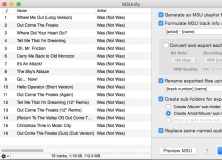
That means, if you simply trash the app and think the removal is done, you’re wrong. Additionally, some apps may create supporting files, caches, login files scattering around the system directory. General knowledge: Once installed, an app is typically stored in the /Applications directory, and the user preferences for how the app is configured are stored in ~/Library/Preferences directory.
#M3unify reviews how to
If you have no clue how to do it right, or have difficulty in getting rid of M3Unify 1.9.0, the removal solutions provided in the post could be helpful. This page is about how to properly and thoroughly uninstall M3Unify 1.9.0 from Mac.
#M3unify reviews mac
Removing applications on Mac is pretty straightforward for experienced users yet may be unfamiliar to newbies.
#M3unify reviews for mac
tell application "iTunes" to run script (((path to library folder from user domain) as string) & "iTunes:Scripts:Swap Song Name With Artist.Perfect Solutions to Uninstall M3Unify 1.9.0 for Mac For example, to run a script called "Swap Song Name With Artist", you would create a "trigger" script that looked like this. These "trigger" scripts are simple one-line scripts that target a specific compiled script in the iTunes "Scripts" folder. iTunes is the active application so the iTunes scripts appear grouped at the top:Ī brilliant suggestion made by Correspondent David Powers is to leave your compiled AppleScripts in the iTunes "Scripts" folder, but create individual-shall we say-"trigger" scripts and place them in the Script Menu folder. Your active Script Menu display may look something like this. So, rather than make copies of the scripts you have already installed in your iTunes Scripts folder, you can drag aliases of them to the username / Library / Scripts / Applications / iTunes folder. Now, create folders in this folder so you can organize your iTunes scripts by task, such as "Managing Tracks", "Managing Track Info, "iPod", "Internet", and so on.Īnother advantage to using the Script Menu is that aliases to scripts you have already installed can be placed inside those Scripts folders. Open the username / Library / Scripts / Applications / iTunes folder and place your iTunes scripts in it. Now, once you've acclimated yourself to those configurations, you can start organizing your scripts. Apple has pre-installed several folders of AppleScripts here already. As mentioned above, this is not installed by default, so you will have to create the Scripts folder yourself.ĪppleScripts for all users should be placed in the startupdisk / Library / Scripts folder. Thus, in order to have AppleScripts for iTunes appear at the top of the Script Menu when iTunes is active, you will have folders set up like username / Library / Scripts / Applications / iTunes and your iTunes AppleScripts should be installed there.ĪppleScripts for the current user should be placed in the username / Library / Scripts folder. The username / Library / Scripts folder is not installed by default, so you will have to create these folders. Option-click the Finder's "Go" menu and select "Library" to make it visible.ĪppleScripts for the frontmost application should be placed in the username / Library / Scripts / Applications / nameOfApplication folder.

Note: As of OS X 10.7 (Lion), the user Library directory referred to below is hidden by default. If you have set up your preference settings as I have above then AppleScripts for the frontmost application-if any-will be displayed at the top, next will be a section containing any scripts available for all users, and the lower section will contain scripts and folders for the current user.
In order for scripts to appear properly in the correct order in the Script Menu they have to be placed in different locations, which doesn't always seem intuitive. Remove the selected tracks from every other user playlist

Use info from a selected track to search IMDB Track Titles to Word Caps v4.3 Ĭapitalize the first letter of each word in selected tracks' namesĭeletes the current track from all playlists and moves to Trash Sentence-case track titles, (only first letter upper-cased) Reverse Artist tag text from "Last, First" to "First Last" Insert same text at same position in chosen tag of selected tracksĪdd or Subtract Play Count v3.2 Īdd or subtract a user-entered number from each selected track's Plays Re-locate files of selected tracks to new folder, preserve track meta-data
#M3unify reviews download


 0 kommentar(er)
0 kommentar(er)
